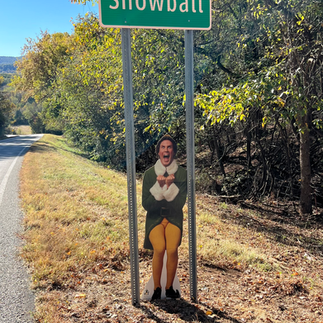Clarksville, Arkansas
October 19, 2022
The unincorporated community of Snowball in Searcy County is typical of the many Arkansas towns established in the Ozark Mountains in the late nineteenth century. Located about thirteen miles west of the county seat of Marshall on state Highway 74, this once thriving commercial community today consists of a Masonic Hall, a few residences, and no commercial businesses.
The area along the banks of Calf Creek, near modern-day Snowball, was settled by Native Americans dating back to the Late Archaic Period. A Native American site, Cooper’s Bluff, was added to the National Register of Historic Places in 1982. One of the earliest white settlers is believed to have been John Campbell, who settled with his family along the creek in about 1837. He soon constructed a grist mill. Benjamin Taylor, another early settler, built a steam-powered grist mill in 1875. The steam engine exploded in 1879, destroying the mill and killing four men. The mill was rebuilt the next year. Taylor also built the area’s first cotton gin. While others moved into the area, no semblance of a real town existed prior to the late 1800s, though a post office called Calf Creek was established in the area in 1857.
In 1885, Calf Creek Masonic Lodge No. 426 was founded. On March 27, 1886, land for a lodge, around which Snowball would grow, was purchased. The two-story stone building, which also served as a church and school, was erected at a cost of $329.75. Members decided to name the lodge in honor of the county sheriff Benjamin Franklin Snow; thus the lodge was named Snow Hall. As the settlement began to grow, a petition was made in 1888 for the establishment of a post office. Local lore says that the documents submitted with the name Snow Hall were misinterpreted by postal officials, and the name was recorded as Snowball.
The post office was officially opened in 1888. The first store had been established by Bill Taylor and the first hotel by A. R. Bradley, both in about 1890. By the early 1900s, the small community had a thriving business sector supplying the local people with needed goods. Expectations ran high when, in 1912, a stave mill was established approximately four miles south of the town. Many of the local residents were employed at the mill. It remained in operation for several years before being relocated to Marshall.
On October 19, 1945, a fire destroyed much of the business district. The post office and at least three businesses were destroyed. The loss was estimated at approximately $20,000. Although the post office was reestablished, it was permanently closed in 1966.
A new school building was constructed by the Works Progress Administration (WPA)in 1938, but by the 1970s enrollment had declined to approximately thirty students; the school gymnasium, built in 1956, is listed on the National Register of Historic Places. A film, The Right To Learn, produced by the Arkansas Department of Educationdocumented that first- through twelfth-grade students were taught by three teachers and transported by one school bus, and the building was heated by a wood stove. Severe weather and yearly floods resulted in an average of two months of absenteeism each year for some students. In 1978, the school was consolidated with Marshall’s schools.
By the 1970s, the community, which at its peak had numbered about 500 residents, had shrunk to approximately four families. The community experienced a brief resurgence in the 1970s initiated by the back-to-the-land movement. It consisted of a number of college-educated young people, called “hippies” by some, who were eager to return to the basics of life. Many chose the Snowball area as their new home. By 1976, seven of the ten farms in the area were owned by members of these new groups. Two of the more prominent were the Dry Creek Farmers and the Home Farmers. As the movement lost momentum, many of the newcomers left.
In the twenty-first century, the town has few residents. The Masonic hall is still active, as is the Snowball Baptist Church. Jimmy Driftwood, who won a Grammy Award for his song “The Battle of New Orleans,” served as a superintendent, teacher, and coach at Snowball in the 1950s. The Old Snowball House, located in an old renovated store, offers items for sale and space for rent.











































































Comentarios